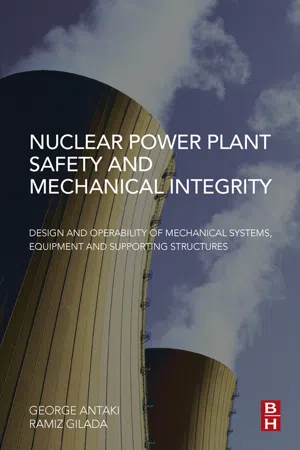
Nuclear Power Plant Safety and Mechanical Integrity
Design and Operability of Mechanical Systems, Equipment and Supporting Structures
- 354 pages
- English
- ePUB (mobile friendly)
- Available on iOS & Android
Nuclear Power Plant Safety and Mechanical Integrity
Design and Operability of Mechanical Systems, Equipment and Supporting Structures
About This Book
One of the most critical requirements for safe and reliable nuclear power plant operations is the availability of competent maintenance personnel. However, just as the nuclear power industry is experiencing a renaissance, it is also experiencing an exodus of seasoned maintenance professionals due to retirement. The perfect guide for engineers just entering the field or experienced maintenance supervisors who need to keep abreast of the latest industry best practices, Nuclear Power Plant Maintenance: Mechanical Systems, Equipment and Safety covers the most common issues faced in day-to-day operations and provides practical, technically proven solutions. The book also explains how to navigate the various maintenance codes, standards and regulations for the nuclear power industry.
- Discusses 50 common issues faced by engineers in the nuclear power plant field
- Provides advice for complying with international codes and standards (including ASME)
- Describes safety classification for systems and components
- Includes case studies to clearly explain the lessons learned over decades in the nuclear power industry
Frequently asked questions
Information
Regulations, Codes, and Standards
Abstract
Keywords
ACI code; Advisory committee on reactor safeguards (ACRS); AISC & AISI Codes; ANS; ASTM; AWS; IEEE standards; ANSI/ASME B31.1; ASME B&PV; ASME O&M; ASME Section III division 1; Boundaries; Classifications; Code cases; Code of federal regulations 10 CFR part 50; Codes and standards; Design; Essential; General design criteria; Generic letters; Bulletins and information notices; Inservice inspection; Loadings; NRC functions and organization; NUREGs; Regulations; Codes and standards; Regulatory guides; Safety class 1, 2 & 3; Seismic category; Service levels; Standard review plan; Structures, systems and components (SSCs); Testing1.1. Requirements
1.1.1. Regulation
Why start the book with regulations?
How are engineering activities regulated in the nuclear power industry?
What are the functions of the NRC?
How is the NRC organized?
What is the ACRS?
How are the regulations organized?
To what extent do the CFRs affect engineering?
What are the upper-level safety requirements?
Table of contents
- Cover image
- Title page
- Table of Contents
- Copyright
- Biography
- Preface
- Acknowledgments
- Acronyms and Description
- Chapter 1. Regulations, Codes, and Standards
- Chapter 2. Design Basis Loads and Qualification
- Chapter 3. Examination and Leak Testing
- Chapter 4. Suspended Systems
- Chapter 5. Supporting Structures
- Chapter 6. Materials and Aging Mechanisms
- Chapter 7. Operability and Industry Operating Experience
- Annex 1. Generic Letters
- Annex 2. Bulletins
- Index